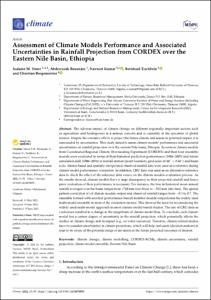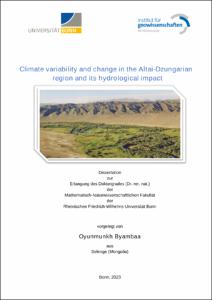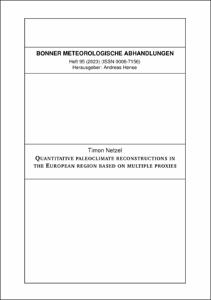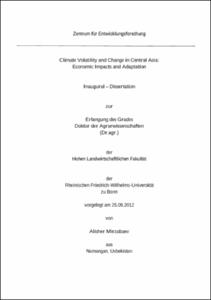Yimer, Sadame; Bouanani, Abderrazak; Kumar, Navneet; Tischbein, Bernhard; Borgemeister, Christian: Assessment of Climate Models Performance and Associated Uncertainties in Rainfall Projection from CORDEX over the Eastern Nile Basin, Ethiopia. In: Climate. 2022, vol. 10, iss. 7, 1--32.
Online-Ausgabe in bonndoc: https://hdl.handle.net/20.500.11811/10749
Online-Ausgabe in bonndoc: https://hdl.handle.net/20.500.11811/10749
@article{handle:20.500.11811/10749,
author = {{Sadame Yimer} and {Abderrazak Bouanani} and {Navneet Kumar} and {Bernhard Tischbein} and {Christian Borgemeister}},
title = {Assessment of Climate Models Performance and Associated Uncertainties in Rainfall Projection from CORDEX over the Eastern Nile Basin, Ethiopia},
publisher = {MDPI},
year = 2022,
month = jun,
journal = {Climate},
volume = 2022, vol. 10,
number = iss. 7,
pages = 1--32,
note = {The adverse impact of climate change on different regionally important sectors such as agriculture and hydropower is a serious concern and is currently at the epicentre of global interest. Despite the extensive efforts to project the future climate and assess its potential impact, it is surrounded by uncertainties. This study aimed to assess climate models’ performance and associated uncertainties in rainfall projection over the eastern Nile basin, Ethiopia. Seventeen climate models from Coordinated Regional Climate Downscaling Experiment (CORDEX) and their four ensemble models were evaluated in terms of their historical prediction performance (1986–2005) and future simulation skill (2006–2016) at rainfall station (point location), grid-scale (0.44° × 0.44°) and basin scale. Station-based and spatially interpolated observed rainfall data were used as a reference during climate model performance evaluation. In addition, CRU data was used as an alternative reference data to check the effect of the reference data source on the climate models evaluation process. As the results showed, climate models have a large discrepancy in their projected rainfall and hence prior evaluation of their performance is necessary. For instance, the bias in historical mean annual rainfall averaged over the basin ranges from +760 mm (wet bias) to −582 mm (dry bias). The spatial pattern correlation (r) of climate models output and observed rainfall ranges from −0.1 to 0.7. The ensemble formed with selected (performance-based) member models outperforms the widely used multi-model ensemble in most of the evaluation metrics. This showed the need for reconsidering the widely used multi-model approach in most climate model-based studies. The use of CRU data as a reference resulted in a change in the magnitude of climate model bias. To conclude, each climate model has a certain degree of uncertainty in the rainfall projection, which potentially affects the studies on climate change and its impact (e.g., on water resources). Therefore, climate-related studies have to consider uncertainties in climate projections, which will help end-users (decision-makers) at least to be aware of the potential range of deviation in the future projected outcomes of interest.},
url = {https://hdl.handle.net/20.500.11811/10749}
}
author = {{Sadame Yimer} and {Abderrazak Bouanani} and {Navneet Kumar} and {Bernhard Tischbein} and {Christian Borgemeister}},
title = {Assessment of Climate Models Performance and Associated Uncertainties in Rainfall Projection from CORDEX over the Eastern Nile Basin, Ethiopia},
publisher = {MDPI},
year = 2022,
month = jun,
journal = {Climate},
volume = 2022, vol. 10,
number = iss. 7,
pages = 1--32,
note = {The adverse impact of climate change on different regionally important sectors such as agriculture and hydropower is a serious concern and is currently at the epicentre of global interest. Despite the extensive efforts to project the future climate and assess its potential impact, it is surrounded by uncertainties. This study aimed to assess climate models’ performance and associated uncertainties in rainfall projection over the eastern Nile basin, Ethiopia. Seventeen climate models from Coordinated Regional Climate Downscaling Experiment (CORDEX) and their four ensemble models were evaluated in terms of their historical prediction performance (1986–2005) and future simulation skill (2006–2016) at rainfall station (point location), grid-scale (0.44° × 0.44°) and basin scale. Station-based and spatially interpolated observed rainfall data were used as a reference during climate model performance evaluation. In addition, CRU data was used as an alternative reference data to check the effect of the reference data source on the climate models evaluation process. As the results showed, climate models have a large discrepancy in their projected rainfall and hence prior evaluation of their performance is necessary. For instance, the bias in historical mean annual rainfall averaged over the basin ranges from +760 mm (wet bias) to −582 mm (dry bias). The spatial pattern correlation (r) of climate models output and observed rainfall ranges from −0.1 to 0.7. The ensemble formed with selected (performance-based) member models outperforms the widely used multi-model ensemble in most of the evaluation metrics. This showed the need for reconsidering the widely used multi-model approach in most climate model-based studies. The use of CRU data as a reference resulted in a change in the magnitude of climate model bias. To conclude, each climate model has a certain degree of uncertainty in the rainfall projection, which potentially affects the studies on climate change and its impact (e.g., on water resources). Therefore, climate-related studies have to consider uncertainties in climate projections, which will help end-users (decision-makers) at least to be aware of the potential range of deviation in the future projected outcomes of interest.},
url = {https://hdl.handle.net/20.500.11811/10749}
}









